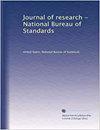Preliminary list of terms for the arc spectrum of tantalum
引用次数: 5
Abstract
A preliminary list of Ta i terms, accounting for most of the strong arc lines, is presented. The low 4F and 4P terms and the metastable 6D and 4D terms are identified with those to be expected theoretically from the electron configurations 5d*>Qs 2 and 5d 4 -6s. CONTENTS Page I. Introductory note 277 II. Term table for Ta i 278 I. INTRODUCTORY NOTE The arc and spark spectra of tantalum have been observed at the Bureau of Standards from 2,000 A in the ultraviolet to 10,300 A in the infrared. These spectra are exceedingly rich in lines and the work of compiling the wave lengths and separating them according to the degree of ionization of the emitting atoms is still incomplete. Many of the arc lines are clearly complex, but are not sufficiently resolved on our plates to give their exact structure. Zeeman effects for many of the tantalum lines have been observed also, but only a few of them, apparently, are based on the gr-values of simple (LS) coupling. With the aid of these new data, we have been able to classify most of the strong Ta i lines, including those that are complex. The terms upon which this classification is based are given in the table below and are offered at this time in response to several requests that have been made of the Bureau of Standards for them. Theoretically the terms result from the interaction of five valence electrons which occupy the O and P shells. In the unexcited state of the atom the electrons form the configuration 5d 3 • 6s from which arise the even terms F, P, H, G, etc. The configuration 5c/ 4 . 6s gives the metastable terms D, D, H, G, I, etc. The more prominent terms of these groups have now been found and it is their combinations with higher odd terms that account for most of the strong Ta i lines. At this stage of the analysis, it is not possible to arrange with certainty these odd terms into multiplet groups and to assign specifically to each its electronic origin. Accordingly, in this preliminary note, the odd terms are designated only by their inner quantum numbers, affixed to the letters Z, Y, X, etc., except in a few instances where the term character is clearly indicated by the Zeeman effect. The numerical values of the terms are arbitrarily based on the assumption that the lowest term is F^ = 0.00. 277 278 Bureau of Standards Journal of Research II. TERM TABLE FOR Ta I Term type V Term type V FW 0.0 Vfe 26, 960. 4 F2^ 2, 010. Uk 28, 133. 9 F3^ T2^ 28, 188. 4 4F^ 5, 621. 4D^ 28, 862. 1 Poh 6, 049. 4 ~&ht 30, 894. 7 Pih 6, 068. 9 Q2H 31, 600. 9 ^2H Pfo 31, 961. 4 0& 32, 486. 8 4V y2 4D^ 9, 975. 8 Ni* 34, 792. 2 4D 2^ 9, 253. 5 M§^ 35, 707. 3 D3^ 10, 690. 3 Ll^ 35, 876. 5 K§h 36, 069. 2 Doh 9, 759. 6D1H 10, 950. 2 Z§h 23, 926. 7 6D2H 11,243. 6 Y334 24, 981. 8 6I^ 12, 234. 7 x§^ 26, 585. 9 E>4K 13, 351. 5 W$* 27, 780. 6 Vfe 28, 182. 6 z§^ 23, 355. 4 Ufca 29, 723. Yo3^ 24, 516. 7 T334 30, 015. 6 4D§^ 25, 512. 6 R§^ 33, 197. 7 2Qta 26, 866. Q§^ 35, 858. 8 W§H 38, 994. 3 P314 37, 143. 3 Zf^ 24, 243. 4 o§^ 38, 253. 3 Yi^ 24, 739. N§^ 39, 526. 7 Xfj^ 26, 363. 7 Mfc 39, 596. 1 Wi« 26, 590. L§^ 40, 755. 8 ^m 28, 689. 4 Kfe 43, 177. 2 4 Pf>s 31, 066. 4 Zlj^ 25, 185. 9 S!^ 30, 664. 7 Yljjj 25, 926. 3 V!m 31, 871. 4 Xl^ 27, 733. 4 U!k 35, 487. 2 Wfc 28, 766. 6 Tih 36, 013. 9 v& 30, 021. 2 Rij^ 37, 523. 6 u?H 34, 094. 6 Ql^ 39, 587. 8 Tly2 43, 090. 3 z2^ 22, 047. 5 Yfc 25, 181. 1 3Z-2H 26, 219. 6 W°2H 26, 794. 8 Washington, June 9, 1933.钽的弧谱术语初步表
本文提出了一份关于大多数强弧线的塔i项的初步清单。低4F和4P项以及亚稳6D和4D项与电子构型5d*>Qs 2和5d 4 -6s的理论预期一致。第1页导言钽的电弧和火花光谱已在标准局从2000 A的紫外线到10300 A的红外波段观测到。这些光谱的谱线非常丰富,编纂波长并根据发射原子的电离程度把它们分开的工作还没有完成。许多弧线显然很复杂,但在我们的平板上还不能充分地分辨出它们的确切结构。许多钽谱线的塞曼效应也被观察到,但显然只有少数是基于简单(LS)耦合的gr值。在这些新数据的帮助下,我们已经能够对大多数强Ta i线进行分类,包括那些复杂的。这种分类所依据的术语如下表所示,是根据标准局提出的几项要求而提供的。理论上,这些项是由占据O层和P层的五个价电子相互作用产生的。在原子的非激发态中,电子形成5d3•6s构型,由此产生偶项F、P、H、G等。配置5c/ 4。6给出亚稳项D、D、H、G、I等。这些类群中较突出的项现在已经被发现,它们与较高的奇数项的组合构成了大多数强Ta i谱线。在分析的这个阶段,不可能确定地把这些奇数项安排成多个组,并具体地为每个组指定其电子来源。因此,在这个初步的说明中,奇数项只由它们的内部量子数来指定,加上字母Z, Y, X等,除了在少数情况下,术语的特征是由塞曼效应明确表示的。这些项的数值是基于最低项为F^ = 0.00的假设而任意设置的。277 278标准局研究学报2。术语表I术语类型V术语类型V FW 0.0 Vfe 26,9604f2 ^ 2,010。英国28,133。9f3 ^ t2 ^ 28,188。4f ^ 5,621。4d的28,862次方。1 Poh 6,049。4 ~ 30,894。7 Pih 6,068。9q2h 31,600。9 ^ 2hp31,961。40 & 32, 486。84vy24d ^ 975。8 . Ni* 34,792。24d 2^ 9, 253。5 m§35,707。3d3 ^ 10 690。3的35,876次方。5 K§h 36, 069。2美元9,759。6d110,950。[2] Z§h 23, 926。7 6d2h 11,243。6 y33424,981。8 6i的12次方,234。7 ק^ 26,585。9 e b> 4k 13, 351。5 w * 27,780。6 .生命28,182。6 z§^ 23,355。4 Ufca 29,723。y3的24,516次方。[33430,015]4d§^ 25,512。6 r§^ 33,197。7 . qta 26,866。Q§^ 35,858。8 w§h 38,994。3 p314 37,143。Zf^ 24,243。4 o§^ 38,253。3 Yi的24,739次方。N§^ 39,526。Xfj^ 26,363。7 Mfc 39, 596。[1] [au:]L§40,755。8 ^ m28,689。[4] [qh]2 . 4 . pb> . 31,066。4 Zlj^ 25,185。9年代!^ 30,664。[au:] [au:]3 V !31,871。4xl ^ 27,733。4 U !k35,487。2世界气象28,766。6 .我有36,013。9 v& 30,021。2 Rij^ 37,523。6 u ?34,094。6 Ql^ 39,587。[au:] [au:]3z2的22,047次方。[5]中国农业大学学报(自然科学版);1 3z-2h 26, 219。6 w°2h 26,794。1933年6月9日,华盛顿
本文章由计算机程序翻译,如有差异,请以英文原文为准。
求助全文
约1分钟内获得全文
求助全文

 求助内容:
求助内容: 应助结果提醒方式:
应助结果提醒方式:


